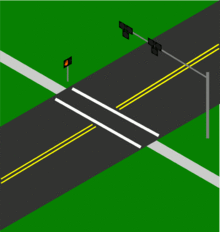HAWK beacon

A HAWK beacon (High-Intensity Activated crossWalK beacon) is a traffic signal used to stop road traffic and allow pedestrians to cross safely. It is officially known as a Pedestrian Hybrid Beacon (PHB). The purpose of a HAWK beacon is to allow protected pedestrian crossings, stopping road traffic only as needed. Where standard traffic signal 'warrants' prevent the installation of standard three-color traffic signals, the HAWK beacon provides an alternative.
A HAWK beacon is used only for crosswalks; however, there is potential for it to be applied to crossings on multi-use paths. Similar hybrid beacons are allowed at driveways of emergency service buildings such as fire houses.[1]
Design and Operation
The vehicular signal faces suspended above the roadway have two round red lenses side-by-side, above a single yellow lens. There must be at least two HAWK signal faces facing each vehicular approach to the crossing. Normal pedestrian signal faces control pedestrian traffic.
The Manual on Uniform Traffic Control Devices has guidelines that should be met before a HAWK beacon is installed. The guidelines consider pedestrian and vehicle traffic volumes, vehicle speeds, and roadway width.
Unlike an ordinary traffic signal, the HAWK beacon only lights when activated by a pedestrian who wishes to cross. The pedestrian crossing faces display an upraised hand (don't walk) signal during this phase.[2] When a pedestrian activates the beacon (generally by a push-button), the HAWK beacon sequence is started, first with flashing yellow, then steady yellow, and finally steady red over a period of several seconds. Pedestrian signal heads at either end of the crosswalk display the upraised hand (don't walk) signal until the HAWK beacon displays the steady red signal, at which time, the pedestrian heads display the walking-person (walk) indication.
As at conventional signalized crossings, the pedestrian signals display flashing "don't walk" indications when typical pedestrians no longer have enough time to cross before the HAWK beacon releases cross traffic. At the same time as the flashing "don't walk" indication, the HAWK beacon displays a flashing red indication to vehicular traffic (the equivalent of a stop sign). During this phase, vehicles on the roadway must stop, and may proceed after yielding to pedestrians in the crosswalk. When vehicle traffic is about to restart, the pedestrian signal goes to steady "don't walk". Then, the HAWK beacon goes dark and the pedestrian signal remains in "don't walk" mode until the signal is activated by another pedestrian.
Effectiveness
After a HAWK signal is installed, vehicle/pedestrian crashes can be expected to be reduced by 69%.[3] As many as 97% of motorists comply with the HAWK beacon, higher than signalized crossing, or crossings with flashing yellow beacons.[4]
Some motorist confusion has been reported at newly-installed HAWK beacons. When first introduced to an area, enforcement and public education are needed until users understand how the beacon works. When the beacon has not been activated, some drivers have acted as if the signal is dark due to a power outage, but that has not been experienced by nearly all jurisdictions with HAWKs in operation. The flashing red phase is sometimes misunderstood by drivers farther back in the queue, and they followed the lead driver through the crosswalk instead of stopping at the stop line as required.[3]
History
The first beacon was developed in Tucson, Arizona by Transportation Administrator R. B. Nassi, P.E., Ph.D., and installed in 2000. The bird name HAWK was suggested by his wife. Until December 2009, the HAWK beacon was categorized as an experimental device. United States transportation agencies wishing to use a HAWK signal were required to obtain approval from the Federal Highway Administration, as well as collect and submit data on the effectiveness of the device. It was finally included in the 2009 edition of the US Manual on Uniform Traffic Control Devices as a "Pedestrian Hybrid Beacon."[5]
See also
References
- ↑ Manual on Uniform Traffic Control Devices. Federal Highway Administration. 2009.
- ↑ Mike Chalmers, "New traffic signals make it safer for pedestrians". USA Today, August 9, 2010 Retrieved 2011-06-21.
- ↑ 3.0 3.1 Fitzpatrick, K., and Park, E.S. (July 2010). Safety Effectiveness of the HAWK Pedestrian Crossing Treatment (PDF). Federal Highway Adminsitration.
- ↑ http://transport.ksu.edu/files/transport/imported/Thesis/RanjitPrasadGodavarthy2010.pdf figure 21
- ↑ Manual on Uniform Traffic Control Devices, Chapter 4F, Federal Highway Administration, 2009, http://mutcd.fhwa.dot.gov/pdfs/2009/part4.pdf
External links
- Safety Effectiveness of the HAWK Pedestrian Crossing Treatment, Federal Highway Administration, July 2010
- Brochure from Alexandria, Virginia, USA describing the operation of HAWK beacons
- Video of a HAWK beacon in operation in Tucson, Arizona, USA
- Discussion of a HAWK beacon on a major street which crosses a bicycle route in Portland, Oregon, USA